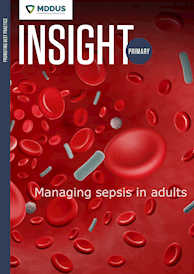MOST experienced GPs will have at least one scare story involving sepsis. Mine occurred around a decade ago in the pre-pandemic world when perhaps GPs had a lower threshold for undertaking home visits. I was asked to visit a previously well 20-year-old lady who was in the UK for a university exchange year and living with a host family. She had been unwell for 48 hours with “a tummy bug” and despite my best endeavours was apparently too unwell to come to the surgery. A home visit was rather reluctantly agreed.
On arrival, I met with the host mother and completed some obligatory paperwork and tried to take a collateral history. There seemed to be little of immediate concern – until we moved into the room to see the patient. She was clearly confused with mottled skin, profound cyanosis and unrecordable blood pressure. Fortunately, we were able to secure an emergency transfer to A&E within 10 minutes and after a period in ICU she made a full recovery. The consultant anaesthetist in ICU subsequently informed me that a delay of even one more hour would have led to a tragic outcome.
This case is at the severe end of the primary care spectrum, but how can GPs identify sepsis, predict which patients are at risk and ensure that those patients are empowered to seek review should their condition worsen?
NICE (NG51) – Sepsis: Recognition, diagnosis and early management
NG51 is the definitive UK guidance on sepsis and includes multiple algorithms for assessing the risk factors for sepsis and its risk stratification (dependant on age and whether the patient is located in primary or secondary care).
The key risk factors for sepsis are:
- Age < 1 year or > 75 years (or the very frail)
- Trauma or surgery/invasive procedure within six weeks
- Impaired immunity due to illness or medication
- Indwelling lines, catheters, IV drug misuse or any breach of the skin (e.g. burns, ulcers etc)
- Consider the additional risk factors for women who are pregnant or have been pregnant within the last six months.
If sepsis is suspected, NICE 51 (1.4 Stratifying risk of severe illness or death from sepsis) suggests patients are stratified according to low, moderate-high or high-risk criteria (Tables 1, 2 and 3). This risk stratification is based primarily on history and observations, including respiratory rate, blood pressure, pulse, temperature, hydration (urine passed) and appearance of the skin.
Patients thought to be at low risk of sepsis can be offered standard care with the usual advice regarding when and how to seek review should their condition progress.
Those patients felt to be at moderate to high risk of sepsis require a more detailed assessment of their underlying condition and a joint decision on place of care. Factors for a GP to consider in deciding the best place of care include:
- Can the underlying cause be identified and treated in the community?
- Is the patient able to seek review if they become more unwell (e.g. does the patient have cognitive impairment, communication difficulties, the presence or absence of an advocate)?
- What are the patient’s preferences and attitude to risk?
- Geographical variations in likely response times should the patient become more unwell.
Patients felt to be at high risk of sepsis should be admitted urgently to an emergency care setting. The decision on how to convey patients into an emergency setting should also consider likely ambulance response times and the risks versus benefits of a non-ambulance transfer to hospital. Patients and their family should be involved in this decision-making process.
Remote assessment
Unfortunately, the NICE guidance offers relatively little advice on the remote assessment of sepsis. This is problematic in the post-pandemic world of UK general practice where many initial consultations continue to be offered by telephone. Although some of the criteria contained within the risk stratification tools can be used remotely (behaviour, immunocompromise, recent surgery and urine output) the majority require direct, face-to-face assessment.
The UK Sepsis Trust has tried to address this omission through its Sepsis Screening Tool Telephone Triage (age 12+). This tool incorporates elements of the Academy of Medical Royal Colleges’ statement on the initial antimicrobial treatment of sepsis (October 2022). The tool follows a similar stepwise approach to NICE 51 with an emphasis on identifying any red flag symptoms for sepsis:
- Objective evidence of new or altered mental state
- Unable to stand/collapsed
- Unable to catch breath/barely able to speak
- Very fast breathing
- Skin that is very pale, mottled, ashen or blue
- Rash that doesn’t fade when pressed firmly
- Recent chemotherapy
- Not passed urine in previous 18 hours.
The guidance suggests that patients with even a single red flag should be referred immediately for a 999 response. Whilst this is a sensitive tool for sepsis, its application in a remote consultation setting could be difficult and GPs may wish to consider the option of an urgent face-to-face assessment to allow more objective measurements to be completed.
Documentation
All patients with sepsis should have the following documentation clearly recorded. This is of particular importance in those patients who are managed in the community:
- An assessment of the risk factors for sepsis
- A complete set of baseline observations (temp, pulse, blood pressure, respiratory rate)
- An indication of the likely source of infection and proposed treatment
- A discussion with the patient (or family member in a patient who lacks capacity) around place of care and the inherent risk associated with remaining in the community
- Clear safety netting advice – to include how to access a review in the event of a deterioration. In documenting high-risk encounters, it is important for GPs to include the specific advice given in relation to what symptoms and signs to look out for and how to seek help, should the condition get worse.
Summary
Sepsis is an insidious, high-risk illness. It is not always possible to immediately identify which patients might progress to become more seriously unwell. GPs carry the burden of this uncertainty and a structured approach to the problem will allow them to minimise the risk, treat patients safely in the community and ensure that those who do become more unwell can seek medical review in a timely fashion. Careful documentation will be invaluable to any colleagues who subsequently review the patient. It will also offer protection to the GP in the event of any subsequent adverse outcome.
References
- NICE (NG51) – Sepsis: Recognition, diagnosis and early management
- The UK Sepsis Trust – Screening and action tool for adults, children and young people 12 years and older
- Academy of Medical Royal Colleges statement on the initial antimicrobial treatment of sepsis
This page was correct at the time of publication. Any guidance is intended as general guidance for members only. If you are a member and need specific advice relating to your own circumstances, please contact one of our advisers.
Read more from this issue of Insight Primary

Save this article
Save this article to a list of favourite articles which members can access in their account.
Save to library



